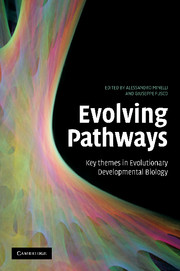Book contents
- Frontmatter
- Contents
- Contributors
- Preface
- Introduction: Pathways of change
- Part I Thinking about evolution by taking development on board
- 1 Evo-devo as a discipline
- 2 Making evolutionary predictions about the structure of development and morphology: beyond the neo-Darwinian and constraints paradigms
- 3 Conflicting hypotheses on the nature of mega-evolution
- 4 Prospects of evo-devo for linking pattern and process in the evolution of morphospace
- 5 The molecular biology underlying developmental evolution
- 6 Evo-devo's identity: from model organisms to developmental types
- Part II Evo-devo: methods and materials
- Part III Evolving diversity
- Part IV Evolving body features
- Index
- References
5 - The molecular biology underlying developmental evolution
Published online by Cambridge University Press: 08 August 2009
- Frontmatter
- Contents
- Contributors
- Preface
- Introduction: Pathways of change
- Part I Thinking about evolution by taking development on board
- 1 Evo-devo as a discipline
- 2 Making evolutionary predictions about the structure of development and morphology: beyond the neo-Darwinian and constraints paradigms
- 3 Conflicting hypotheses on the nature of mega-evolution
- 4 Prospects of evo-devo for linking pattern and process in the evolution of morphospace
- 5 The molecular biology underlying developmental evolution
- 6 Evo-devo's identity: from model organisms to developmental types
- Part II Evo-devo: methods and materials
- Part III Evolving diversity
- Part IV Evolving body features
- Index
- References
Summary
Stephen Jay Gould opens the Prospectus of his influential Ontogeny and Phylogeny (Gould 1977) with the following quotation from Van Valen (1973): ‘A plausible argument could be made that evolution is the control of development by ecology. Oddly, neither area has figured importantly in evolutionary theory since Darwin, who contributed much to each. This is being slowly repaired for ecology … but development is still neglected.’
As accurate as these comments may have been in 1977, today, 30 years later, they no longer hold true: two new fields centred on the study of organismal development have now emerged in modern biology. One of them, which has successfully married the traditional fields of embryology and genetics, is the field of developmental genetics. The other one is known as developmental evolution, evolutionary developmental biology or simply evo-devo, and is the primary subject of this book and this chapter.
The evo-devo field has set as its ultimate goal to provide a mechanistic explanation of how developmental mechanisms changed during evolution, and how these alterations are causally linked to modifications in morphological patterns (Holland 1999). These questions are most relevant, as, so far, the formal structure of the evolutionary theory has been based upon the dynamics of alleles, individuals and populations under selective pressures and genetic drift ‘assuming’ the prior existence of these entities (Fontana and Buss 1993).
Information
- Type
- Chapter
- Information
- Evolving PathwaysKey Themes in Evolutionary Developmental Biology, pp. 80 - 99Publisher: Cambridge University PressPrint publication year: 2008
References
Accessibility standard: Unknown
Why this information is here
This section outlines the accessibility features of this content - including support for screen readers, full keyboard navigation and high-contrast display options. This may not be relevant for you.Accessibility Information
- 5
- Cited by
